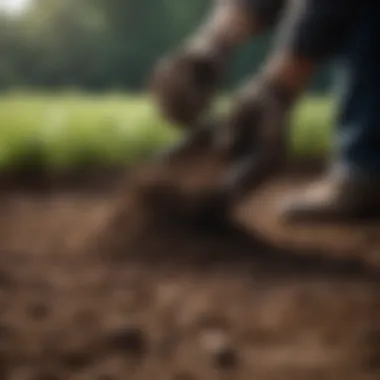Essential Guide to Growing Grass from Seed


Intro
Growing grass from seed can seem daunting, yet it is a rewarding experience for many homeowners and gardening aficionados. A lush lawn enhances the landscape and brings a sense of satisfaction. Understanding the steps involved is crucial to ensure success in achieving the desired results. This guide will delve into several aspects of grass cultivation, including soil preparation, seed selection, sowing techniques, and ongoing care. Each of these elements plays a vital role in creating a vibrant and healthy lawn.
Design Considerations
Creating a successful lawn begins with a thoughtful design. Although grass may appear uniform, various factors contribute to its overall aesthetic and functionality.
Trending Styles
Today's gardening trends emphasize sustainability and biodiversity. Homeowners are opting for grass blends that support local wildlife while maintaining an appealing appearance. Native grass species can provide a more resilient option, requiring less water and fewer chemicals. Investigating regional preferences can offer valuable insights for your own yard.
Color Palettes
When choosing grass, consider the color it contributes to your outdoor space. Cool-season grasses, like Kentucky bluegrass, are popular for vibrant green hues, particularly in spring and fall. Warm-season grasses, such as Bermuda, thrive in summer heat, providing a distinct gold tint. Harmonizing the grass color with surrounding plants enhances the overall visual impact.
A well-planned lawn can transform a plain outdoor area into a desirable gathering space.
Another consideration in design is the functionality of the space. Is it for recreation, relaxation, or aesthetic appeal? Understanding the purpose of your lawn will influence the decisions you make during the seed selection and sowing process.
Maintenance and Upkeep
Once the grass is established, ongoing maintenance is crucial. Proper care ensures a long-lasting and thriving lawn.
Seasonal Maintenance Checklist
- Spring: Fertilize and aerate. Reseed thin areas as needed.
- Summer: Water regularly, taking care to avoid overwatering. Mow to the correct height.
- Fall: Apply a final fertilizer treatment. Prepare for winter by aerating and overseeding.
- Winter: Limit foot traffic on dormant grass to prevent damage.
Cleaning and Organization Tips
Keep gardening tools organized and maintained. Regularly clean debris from the lawn, as it can hinder grass health. Educate yourself on pest management to prevent infestations that could damage your investment. Developing a consistent routine will enhance your ability to keep things in check, allowing you to focus on grass growth and overall yard aesthetics.
Understanding Grass Varieties
Understanding grass varieties is a crucial step when planning your lawn. Not all grasses are suited for every environment. Different types of grass have specific growth habits, ideal conditions, and resilience to various climate challenges. Knowing which variety to choose can lead to a thriving lawn that meets your aesthetic and functional needs.
There are two main categories of grass varieties: cool-season and warm-season grasses. Each type has unique characteristics and best growing conditions, which makes it imperative to choose the right one based on your local climate. This understanding can significantly affect seed germination rates, growth speed, and overall lawn health.
"Optimal grass health begins with selecting the correct variety for your region."
Cool-Season Grasses
Cool-season grasses thrive in the northern regions where temperatures drop during winter and rise in spring and fall. Examples include Kentucky bluegrass, fescue, and ryegrass. These grasses generally grow most actively in the spring and fall when temperatures are cooler.
The benefits of cool-season grasses include:
- Tolerance to cold: They can survive harsh winter conditions and rebound quickly in spring.
- Lush appearance: These grasses produce a deep green lawn, especially in cooler months.
Considerations include:
- Drought sensitivity: They may struggle during extended periods of summer heat.
- Disease susceptibility: High humidity can lead to fungal diseases.
Warm-Season Grasses
Warm-season grasses typically grow best in the southern regions, where temperatures remain warm during summer. Varieties such as Bermuda, Zoysia, and Buffalograss fall into this category. These grasses are more active in the summer months and usually slow down as temperatures drop in the fall and winter.
The advantages of warm-season grasses are:
- Heat tolerance: They thrive in high temperatures, making them ideal for southern climates.
- Drought resistance: Many warm-season grasses require less water once established.
However, challenges exist:
- Potential dormancy: During winter, these grasses may turn brown and go dormant, affecting the lawn's appearance.
- Slow growth in spring: Initial growth in cooler temperatures can be less vigorous.
Choosing the Right Variety for Your Climate
When deciding which grass variety to plant, you should consider your local climate zone. Assessing regional temperature patterns, rainfall, and soil types is essential. Specific grass varieties will perform better based on these factors.
A few points to evaluate:
- Climate Zone: Identify if you live in a cool- or warm-season area.
- Sunlight: Determine how much sunlight your lawn gets; some grasses need full sun while others can tolerate shade.
- Soil Type: Test your soil's pH and nutrient levels to inform your seed selection.


Preparing the Soil for Seeding
Preparing the soil is a fundamental step for successful grass growth. It sets up the necessary foundation where seeds can establish roots and thrive. Quality soil enhances water retention, provides essential nutrients, and fosters a healthy ecosystem for grass growth. Neglecting this process can result in weak grass that struggles to survive and could lead to a patchy lawn. Therefore, investing time and effort into soil preparation is crucial for any homeowner or gardening enthusiast looking to cultivate a lush, vibrant lawn.
Assessing Soil Quality
The first step in preparing soil is to assess its quality. This involves examining texture, structure, and overall health. You can determine the texture by feeling the soil. Sandy soils drain quickly and dry out fast. Clay soils hold moisture but can become compacted. Loamy soil, a mix of sand, clay, and silt, is typically the best for grass since it balances drainage and nutrient retention.
Key indicators of soil health include:
- pH Level: Grass generally prefers a pH of 6.0 to 7.0. Testing kits are available at garden centers to measure this.
- Organic Matter: A good amount of organic material supports microbial life, needed for nutrient availability.
- Soil Compaction: Compacted soil limits root growth.
A simple soil test can give insights into nutrient deficiencies and pH imbalances. This data is essential for effective amendments down the line.
Clearing Debris and Weeds
After assessing the soil, it’s important to clear away any debris or weeds. Debris such as rocks, sticks, and old sod can create barriers for seed growth. Weeds are especially problematic as they compete with grass for light, water, and nutrients.
To effectively clear the area, consider these steps:
- Manual Removal: Pull weeds by hand, ensuring that roots are removed. This is labor-intensive but effective for smaller areas.
- Use a Hoe or Rake: For larger spaces, tools can speed up the cleaning process.
- Herbicides: As a last resort, some homeowners choose chemical herbicides. Caution is advised, as these can harm the grass you plan to plant.
Once the area is trimmed and cleared, it provides an unobstructed space for grass seeds to settle into.
Soil Testing and Amendments
Soil testing helps address imbalances that hinder growth. After identifying nutrient levels and pH, you will know what amendments are necessary. Common items to amend soil include:
- Lime: Used to raise soil pH if too acidic.
- Sulfur: Lowers pH for overly alkaline soils.
- Compost: Enhances soil structure and nutrient content.
- Fertilizers: Provide necessary nutrients like nitrogen, phosphorous, and potassium.
Incorporate amendments based on the test results. It’s usually done by spreading materials over the surface and mixing them into the top few inches of soil. Amending improves soil health and optimizes conditions for germination.
Tilling and Leveling the Soil
Finally, tilling and leveling the soil is important for creating a suitable environment for sowing grass seed. Tilling breaks up hard, compacted soil, which promotes aeration and nutrient distribution. Use a rototiller or garden fork to till the soil to a depth of about 4 to 6 inches.
Once tilled, leveling the soil is the next section. It helps remove bumps and depressions, creating a smooth surface. This can be accomplished by:
- Raking: Smooth out the soil surface with a landscape rake.
- Rolling: A lawn roller can firm up the surface if necessary.
Taking the time to prepare soil through assessment, clearing, testing, amendments, tilling, and leveling creates an environment where grass seeds can flourish, leading to a healthy, green lawn.
Selecting the Right Seed
Choosing the right grass seed is a crucial step in cultivating a lush and healthy lawn. The type of grass you select will affect not only the appearance but also the durability and adaptability of your lawn to various environmental conditions. Selecting the right seed becomes a reflection of your local climate and the specific characteristics you desire in your grass. For instance, some grasses thrive in sunny areas while others tolerate shade better. Ultimately, the right choice lays the foundation for a thriving lawn that meets your aesthetic and functional needs.
Seed Quality and Certification
Seed quality is paramount. When shopping for grass seed, look for clean and viable seeds that meet local standards. Certified seeds are often labeled as such. These seeds have undergone testing to ensure they are disease-free and capable of germinating successfully. The benefits of using quality seeds include higher germination rates, uniform growth, and resilience against pests and diseases.
- Look for labels indicating purity and germination rates. A minimum of 90% germination is a good benchmark.
- Choose reputable brands that are recognized in the industry, as they often adhere to more stringent quality control measures.
Investing in certified seeds can save you time and resources and prevent future lawn issues. It is wise to consult local agricultural extensions or gardening centers for recommendations tailored to your geographic area.
Seed Mixtures vs. Single Varieties
Deciding between seed mixtures and single varieties demands careful consideration of your lawn's specific conditions and use.
- Seed mixtures combine different grass types, which can offer various benefits such as improved resilience to environmental stressors or disease. For instance, a mix of Kentucky Bluegrass and Perennial Ryegrass may enhance drought tolerance while establishing quicker than single varieties alone.
- Single varieties, in contrast, allow for a more uniform lawn appearance. If you prefer a specific look or have consistent growing conditions throughout your yard, choosing a single type might be preferable. However, a single variety may also be more susceptible to diseases or pests that specifically target that species.
Ultimately, your choice will hinge upon your lawn's specific environmental conditions and your aesthetic goals. Balancing between diversity and uniformity will help you achieve the results you want.
"Selecting the right seed is an investment not just in your garden, but in your home and lifestyle."
To conclude, thoughtful choices in seed selection will directly influence your lawn's performance and its ability to thrive throughout the seasons. Consider quality, adaptability, and your personal preferences to cultivate a successful lawn.
Sowing Techniques
Sowing techniques play a pivotal role in the successful growth of grass from seed. This section delves into the importance of effective sowing, exploring nuances such as timing, methods, and seeding rates. Understanding these elements can greatly influence the density, health, and appearance of your lawn. Proper sowing practices ensure an even distribution of seeds, which optimizes germination and establishes a lush, vibrant lawn.


Timing for Sowing Grass Seed
The timing for sowing grass seed is crucial for successful germination and growth. Ideal conditions differ for cool-season and warm-season grasses. Cool-season grasses should generally be sown in early fall or late spring when soil temperatures range from 50°F to 65°F. This ensures that seeds can germinate effectively before the heat of summer. For warm-season grasses, late spring to early summer is best, aligning with soil temperatures between 70°F and 95°F, which promotes rapid growth.
Prior planning is essential. Checking local climate patterns helps determine the best sowing window. Furthermore, consider existing weather conditions. Sowing just before a rain can enhance moisture, creating favorable conditions for seeds.
Methods of Sowing Seed
There are several methods to sow grass seeds, each having advantages and best-use scenarios. Here are some effective techniques:
- Broadcasting: This method involves scattering seeds by hand or using a seed spreader. Broadcasting is useful for covering large areas quickly. However, it necessitates careful calibration to avoid overcrowding.
- Drilling: This technique uses a specialized machine to create small holes in the soil while placing seeds in those holes. Drilling can provide better soil contact for seeds, leading to improved germination rates.
- Patch Seeding: Ideal for small areas where grass is thin or bare, patch seeding involves applying seeds directly to existing grass or soil to fill in gaps. This requires careful soil preparation for effective results.
Each method has its unique benefits. Selecting the appropriate sowing method should align with your lawn's size, condition, and the specific grass variety you have chosen.
Seeding Rate Guidelines
Establishing the correct seeding rate is an important aspect of grass establishment. Too many seeds can lead to competition, while too few can result in patchy growth. Generally, the recommended seeding rate varies based on the grass variety and the intended use of the lawn. For example:
- Perennial Ryegrass: Approximately 5 to 10 pounds per 1,000 square feet.
- Tall Fescue: Around 8 to 12 pounds per 1,000 square feet.
- Kentucky Bluegrass: About 2 to 3 pounds per 1,000 square feet.
When determining the seeding rate, always refer to the seed package instructions, as they often provide specific guidance based on variety. Keep in mind that adjusting for local conditions might be necessary.
Overall, adhering to proper seeding rates not only enhances germination success but also contributes to a healthier and more resilient lawn that can withstand the rigors of weather and foot traffic.
Proper sowing techniques can lead to a thriving lawn, enhancing the beauty and value of your property.
Ultimately, understanding and implementing effective sowing techniques ensures a successful start for your grass seedlings, laying the foundation for a lush and vibrant lawn.
Watering After Sowing
Watering after sowing is a critical step in the grass cultivation process. It influences not only the germination of seeds but also the overall health of your lawn in the long term. Adequate moisture levels are essential for seeds to germinate and thrive. Without the right amount of water, even the best-laid plans for sowing can lead to disappointing results.
Importance of Moisture
Moisture plays a pivotal role in the establishment of grass seeds. Seeds absorb water during a process called imbibition, which is crucial for triggering germination. This initial hydration activates enzymes within the seed, which leads to growth. A moist environment ensures seeds remain in optimal conditions for sprouting. Grass seedlings are particularly sensitive and need consistent moisture during their early stages to develop robust root systems.
Moreover, water helps to transport essential nutrients from the soil to the young plants. A healthy level of moisture creates a favorable environment for beneficial microorganisms that enhance soil health. Without sufficient moisture, seeds may fail to germinate, or seedlings may emerge weak and stunted. Therefore, actively managing soil moisture levels is necessary for successful grass cultivation.
Frequency and Techniques for Watering
Determining the frequency of watering depends on several factors, including soil type, weather conditions, and the specific grass variety.
- Initial Watering: After sowing your seeds, it is generally advised to give them a deep watering. This should be done immediately after planting to help the seeds settle into the soil.
- Ongoing Watering: For the first few weeks, you should aim to keep the soil consistently moist. This often means watering lightly every day or every other day.
- Soil and Weather Considerations: Sandy soils may require more frequent watering than clayey soils because they dry out more quickly. Additionally, on hotter days, the grass may need an extra watering session.
Techniques for watering vary. You can use:
- Sprinklers: They provide an even distribution of water, ensuring all seeds receive moisture.
- Hose or Watering Can: This method allows for more targeted watering, particularly in small areas.
- Soaker Hoses: They can be laid down before sowing, delivering water directly to the soil without surface run-off.
Signs of Overwatering and Underwatering
Recognizing the signs of incorrect watering is crucial for maintaining the health of your new lawn.
Signs of Overwatering:
- Pooled Water: This indicates that the soil cannot absorb any more.
- Yellowing Grass: Overwatered seedlings often turn yellow or may start to die off.
- Mold or Fungus: Excess moisture can lead to fungal growth, such as patches of mold on the surface.
Signs of Underwatering:
- Dry Soil: If the top inch of soil feels dry, it’s time to water.
- Wilting Grass: Grass blades may droop or curl when needing moisture.
- Slow Growth: Seedlings that lack water will not establish properly and will grow at a reduced rate.
Proper watering techniques ensure that seedlings establish their roots effectively, setting the foundations of a lush lawn.
By understanding these elements, you can effectively manage watering to support grass seed growth. This care is vital in fostering a lawn that not only looks good but also thrives in its environment.
Maintaining Lawn Health
Maintaining lawn health is vital for ensuring that your grass thrives throughout the seasons. A well-maintained lawn provides aesthetic appeal, supports biodiversity, and contributes to environmental well-being. There are several essential elements to consider, each playing a role in the overall health and longevity of your grass.
Fertilization Timeline and Techniques


Proper fertilization is crucial for reinforcing the nutrient levels in your soil. Different grass types require varying nutrients at different stages of growth.
- Timing: The ideal fertilization timeline generally aligns with the grass's growing season. For cool-season grasses, fertilizing in early spring and again in the fall is effective. For warm-season varieties, late spring is the optimal time.
- Techniques: You can use different types of fertilizers.
- Granular fertilizers are easy to apply but require watering after application.
- Liquid fertilizers offer quick nutrient absorption but must be applied more frequently.
- Organic options, like compost, can improve soil health over time.
Regularly reviewing your soil's nutrient content through tests can help you adjust your fertilization strategy based on need.
Mowing Practices for New Grass
When it comes to mowing, the first cuts on new grass are particularly important.
- Height: Keep the mower blades high at first, allowing new grass to establish strong roots. Cutting too low may stress the young plants. A height of about 3 inches is suggested for most varieties.
- Frequency: Mow when the grass reaches about one-third taller than your desired height. Regular mowing will encourage lateral growth and a thicker lawn.
- Sharp Blades: Using sharp mower blades promotes clean cuts, reducing the risk of disease. Dull blades tear the grass, making it more susceptible to pests and stress.
These practices help your grass develop resilience and a robust appearance over time.
Controlling Weeds and Pests
Weeds and pests can quickly undermine your efforts in maintaining a healthy lawn. Therefore, managing them effectively is paramount.
- Identification: Understand what weeds are prevalent in your area. For instance, crabgrass is common in many lawns, while dandelions may be more invasive in others.
- Prevention: Regular seeding and fertilization create a dense turf that can outcompete most weeds. A thicker lawn also makes it harder for pests to inhabit.
- Control Methods: You can choose between chemical and non-chemical weed control methods.
- Herbicides can be effective but come with risks to the environment and human health.
- Manual weeding is labor-intensive but ensures that you target specific plants without chemicals.
Remember, proactive lawn care will minimize the impacts of weeds and pests over time. Address issues as soon as you notice them to maintain a healthy lawn.
Establishing good lawn health habits is a continuous process. By following proper fertilization techniques, adhering to mowing practices, and managing weeds and pests, you can ensure your lawn remains vibrant and lush throughout the seasons.
Common Challenges in Grass Growth
Growing grass from seed requires more than just proper techniques in sowing and caring for your lawn. Understanding the common challenges faced during the growth process is crucial for ensuring a healthy and thriving lawn. Acknowledging potential issues can help in implementing effective solutions before they escalate. This section discusses two primary challenges: disease issues and the impact of weather conditions.
Identifying and Addressing Disease Issues
Grass diseases can hinder the growth and overall health of the lawn. Recognizing early signs of disease is essential in preventing further spreading. Common diseases might include brown patch, fusarium blight, and powdery mildew. These diseases often flourish in warm, humid environments and can appear as discolored patches or unusual growth patterns.
To effectively address these issues:
- Monitor lawn health frequently. Regular checks can help spot problems before they worsen.
- Ensure proper air circulation. Thin out areas that are too thick to prevent excess moisture.
- Practice proper watering and fertilization. Over-fertilizing or applying water too frequently can promote disease.
In some cases, using resistant grass varieties can reduce the risk of diseases. If a particular disease is identified, you may need to apply fungicides or adjust your maintenance techniques.
"A proactive approach to lawn care not only prevents disease but also preserves the beauty of your landscape."
Impact of Weather Conditions
Weather conditions play a significant role in the growth of grass. Factors such as temperature, rainfall, and seasonal changes are crucial in determining planting success. For example, heavy rainfall can lead to flooding, which may wash away seeds or drown seedlings. On the other hand, too little rain can cause the soil to dry out, stunting growth and creating an environment for weeds.
Key points to consider regarding weather include:
- Monitor local weather forecasts. This knowledge will guide your sowing and maintenance schedule.
- Be prepared for climate extremes. Protection strategies such as using barriers against heavy rain or adjusting watering during heatwaves can be beneficial.
- Adapt to seasonal changes. Understand that different grass types may respond differently to cold or warm periods.
Coping with weather variations effectively ensures optimal growth conditions for your grass. Adjusting maintenance plans based on seasonal weather patterns is key as well.
Final Thoughts on Grass Cultivation
Cultivating grass from seed is not solely a task but rather a commitment that yields tangible rewards. The journey from seed selection to a flourishing lawn encompasses various practices. It is essential to understand that the success of grass growth depends significantly on the choices made at each phase of cultivation.
Long-Term Lawn Care Strategies
Maintaining a healthy lawn requires ongoing effort and awareness. Several strategies can ensure longevity in lawn health.
- Regular Mowing: Consistent mowing at the appropriate height encourages strong root growth. This minimizes stress on the plants while enhancing their resilience against weeds.
- Seasonal Fertilization: Implement a fertilization schedule that aligns with the growth cycle of the grass variety chosen. Understanding the nutrient needs will promote optimal health and color.
- Weed Management: Keep an eye on emerging weeds. Early intervention is crucial. This includes hand-pulling or applying targeted herbicides to protect the integrity of your grass.
- Aeration: Aerating the soil periodically can relieve compaction and enhance water and nutrient absorption. This is especially important for areas with high foot traffic.
These practices, when executed with diligence, not only ensure the immediate health of your lawn but also its sustainability over time.
Adapting to Changing Conditions
In the world of grass cultivation, adaptability is key. Various factors can alter the condition of your lawn, including climate changes, disease outbreaks, and pest infestations.
- Monitoring Weather Changes: Stay informed about local climate trends. Changes in temperature and precipitation patterns should prompt adjustments in watering and fertilization.
- Soil Testing: Regular soil testing helps to determine nutrient levels and pH balance. This information will guide any necessary amendments to keep the soil conducive for grass growth.
- Pest Control Measures: Be proactive in pest management. Observe for signs of damage and apply appropriate treatments to minimize impact before it escalates.
- Reseeding and Renovation: If certain areas of the lawn struggle, consider reseeding with more resilient varieties or even renovating the lawn altogether. This can address ongoing issues related to poor growth areas.
Proper adaptability to changing conditions is what distinguishes a thriving lawn from one that suffers due to neglect or mismanagement.
These aspects underline the importance of understanding that grass care continues well beyond the initial sowing. The successful cultivation of grass from seed integrates various strategies that cater to both the immediate and future needs of the lawn.







